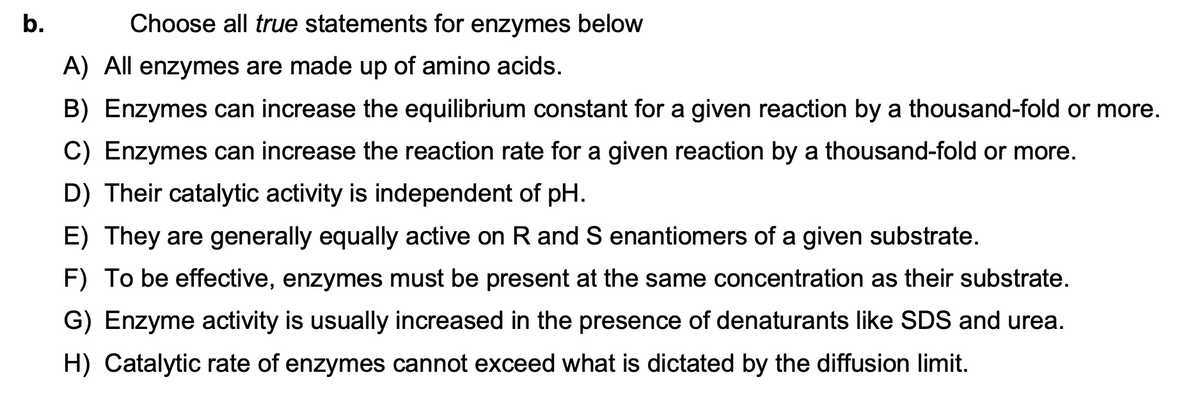A) All enzymes are made up of amino acids. B) Enzymes can increase the equilibrium constant for a given reaction by a thousand-fold or more. C) Enzymes can increase the reaction rate for a given reaction by a thousand-fold or more. D) Their catalytic activity is independent of pH. E) They are generally equally active on R and S enantiomers of a given substrate. F) To be effective, enzymes must be present at the same concentration as their substrate. G) Enzyme activity is usually increased in the presence of denaturants like SDS and urea. H) Catalytic rate of enzymes cannot exceed what is dictated by the diffusion limit.
A) All enzymes are made up of amino acids. B) Enzymes can increase the equilibrium constant for a given reaction by a thousand-fold or more. C) Enzymes can increase the reaction rate for a given reaction by a thousand-fold or more. D) Their catalytic activity is independent of pH. E) They are generally equally active on R and S enantiomers of a given substrate. F) To be effective, enzymes must be present at the same concentration as their substrate. G) Enzyme activity is usually increased in the presence of denaturants like SDS and urea. H) Catalytic rate of enzymes cannot exceed what is dictated by the diffusion limit.
Biochemistry
9th Edition
ISBN:9781319114671
Author:Lubert Stryer, Jeremy M. Berg, John L. Tymoczko, Gregory J. Gatto Jr.
Publisher:Lubert Stryer, Jeremy M. Berg, John L. Tymoczko, Gregory J. Gatto Jr.
Chapter1: Biochemistry: An Evolving Science
Section: Chapter Questions
Problem 1P
Related questions
Question

Transcribed Image Text:b.
Choose all true statements for enzymes below
A) All enzymes are made up of amino acids.
B) Enzymes can increase the equilibrium constant for a given reaction by a thousand-fold or more.
C) Enzymes can increase the reaction rate for a given reaction by a thousand-fold or more.
D) Their catalytic activity is independent of pH.
E) They are generally equally active on R and S enantiomers of a given substrate.
F) To be effective, enzymes must be present at the same concentration as their substrate.
G) Enzyme activity is usually increased in the presence of denaturants like SDS and urea.
H) Catalytic rate of enzymes cannot exceed what is dictated by the diffusion limit.
Expert Solution
This question has been solved!
Explore an expertly crafted, step-by-step solution for a thorough understanding of key concepts.
Step by step
Solved in 2 steps

Knowledge Booster
Learn more about
Need a deep-dive on the concept behind this application? Look no further. Learn more about this topic, biochemistry and related others by exploring similar questions and additional content below.Recommended textbooks for you

Biochemistry
Biochemistry
ISBN:
9781319114671
Author:
Lubert Stryer, Jeremy M. Berg, John L. Tymoczko, Gregory J. Gatto Jr.
Publisher:
W. H. Freeman

Lehninger Principles of Biochemistry
Biochemistry
ISBN:
9781464126116
Author:
David L. Nelson, Michael M. Cox
Publisher:
W. H. Freeman

Fundamentals of Biochemistry: Life at the Molecul…
Biochemistry
ISBN:
9781118918401
Author:
Donald Voet, Judith G. Voet, Charlotte W. Pratt
Publisher:
WILEY

Biochemistry
Biochemistry
ISBN:
9781319114671
Author:
Lubert Stryer, Jeremy M. Berg, John L. Tymoczko, Gregory J. Gatto Jr.
Publisher:
W. H. Freeman

Lehninger Principles of Biochemistry
Biochemistry
ISBN:
9781464126116
Author:
David L. Nelson, Michael M. Cox
Publisher:
W. H. Freeman

Fundamentals of Biochemistry: Life at the Molecul…
Biochemistry
ISBN:
9781118918401
Author:
Donald Voet, Judith G. Voet, Charlotte W. Pratt
Publisher:
WILEY

Biochemistry
Biochemistry
ISBN:
9781305961135
Author:
Mary K. Campbell, Shawn O. Farrell, Owen M. McDougal
Publisher:
Cengage Learning

Biochemistry
Biochemistry
ISBN:
9781305577206
Author:
Reginald H. Garrett, Charles M. Grisham
Publisher:
Cengage Learning

Fundamentals of General, Organic, and Biological …
Biochemistry
ISBN:
9780134015187
Author:
John E. McMurry, David S. Ballantine, Carl A. Hoeger, Virginia E. Peterson
Publisher:
PEARSON